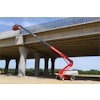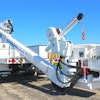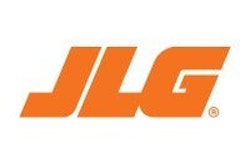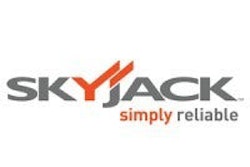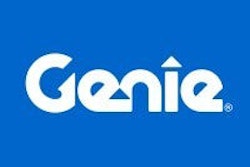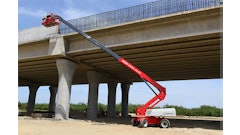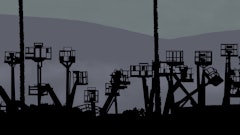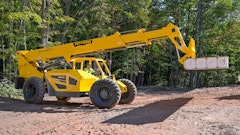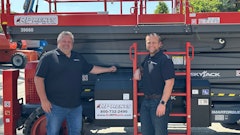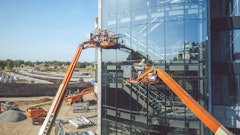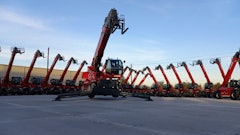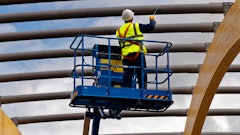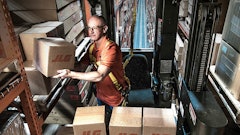
Telehandlers are arguably the MVP of the jobsite, always Johnny-on-the-spot, capable of lifting, loading, picking and placing. Recently, we’re seeing expansion on both ends of the size spectrum with new high-capacity and compact models being introduced. We talked with several leading manufacturers to get a sense of why these telehandlers categories are growing. Following is an excerpt from that discussion.
Rental: Why are we seeing so much expansion on the high-capacity side of the telehandler range?
John Boehme, telehandler product manager, JLG: I think it has a lot to do with the size of the work. We’re talking about large industrial projects where the building materials coming in are much larger. And there are other applications that are growing like solar and wind power, as well as energy exploration and extraction, where you have heavy components that need to be moved to the worksite, sometimes over fairly long distances. These high-capacity machines are very well suited for that kind of work.
Steve Kiskunas, product manager - telescopic handlers, Manitou Group: Contractors are always searching for new methods to improve jobsite efficiency and productivity. The high-capacity telescopic handler can do a wide range of high-capacity material pick and placements without needing a high-capacity crane. Manitou offers models with 20,000 to 72,000 lbs. pick-and-carry capacities.
Josh Taylor, Genie product manager, Terex AWP: The market size in North America for high-capacity telehandlers has shown steady growth in the last five years. Some manufacturers are just now starting to fill out that side of their portfolio, whereas Genie has made a commitment to this market since 2014 when the Genie GTH-1256 model was introduced.
Braden Spence, product manager, telehandlers, Skyjack: The 10,000lb capacity telehandler with a 56’ lift height has proven to be the bread and butter within the telehandler rental market, but due to lifting capabilities and available options, there’s a great opportunity for high-capacity telehandler to displace other equipment lines on a job site. For instance, when operating Skyjack’s ZB2044 equipped with its Hydraulic Winch option, the ZB2044 is capable of displacing the need for a RT crane which was previously used for pipeline work ,equipment maintenance, framing and loading/unloading equipment or materials.
Rental: Regarding compact models, why are these machines getting so much attention right now?
Spence: Compact telehandlers are very versatile, the options are endless. With a skid steer attachment plate, a compact telehandler can use majority of all skid steer attachments up-to its auxiliary hydraulic flow capabilities. With the addition of the skid steer attachment plate, compact telehandlers really rivals a skid steer in terms of versatility. It’s ground engaging, can lift material to height and can maneuver efficiently in very tight spaces.
Taylor: Compact models have a more accessible acquisition price, and they typically are extremely versatile machines, which means utilization is high. The Genie GTH-5519 model is a market leader in the compact space, and it is hard to think of a jobsite where this particular model could not be utilized.
Boehme: We're seeing compacts popping up everywhere, especially in suburban and urban jobsites, simply because of space restrictions. It's the same with some residential work. Take the landscaping/hardscaping market, for example. A 5,500-lb. capacity machine has enough capacity to get the job done. The next machine up is a 6K and it’s twice the size. I think there's some realization that these smaller machines have plenty of capacity and they can really get in and out of tight spaces.
Rental: What is the target application for compacts?
Taylor: Our target customer and application has consistently been construction rental. Most telehandlers being used on sites are rented. Genie aerial lifts are distributed through rental channels, so for our business model, it is a natural fit for telehandlers to be distributed in the same way.
It is hard to imagine these broadening their applications any wider. Telehandlers are typically the first machine on the site and one of the last machines off the site. In Europe, there is a well-developed agricultural telehandler market segment. These machines are as common on farms as the traditional tractor. This market has not yet developed in the North America, although we occasionally receive inquiries about agriculture applications. There’s also an emerging customer base in utility work, although the specification for machines in this segment typically requires a high degree of customization or upfitting.
Additional opportunities may present themselves in the future, but the market is so well developed in its present state that it is challenging to identify any specific applications or site types that do not already utilize these machines.
Kiskunas: Our super compact models are focused generally in the construction rental industry. Manitou launched the MT 420 super compact telehandler last year to great success. These units are designed to be easy to transport and use with the comfort of a full size operator’s cab on a machine that is less than five feet wide.
Rental: What makes the high-capacity and compact classes of telehandlers good choices for rental?
Kiskunas: The high-capacity telescopic handlers are still a new trend for contractors. Many contractors would like to try the concept out before making a large financial investment. Rental allows contractors to try the equipment for specific projects and determine how the equipment can reduce their material placement costs. This is generally good for rental companies, as the high-capacity telescopic handlers tend to go out on long-term rentals where both rates and utilization are high.
Rental: What are some predominant design trends in today’s telehandler models across all sizes?
Boehme: A telehandler is always referred to as the Swiss army knife of a jobsite because it’s typically the first machine on the site and the last machine off. They're expected to be able to do a number of jobs, so with that expectation from the user, the more attachments, the more tools, the more solutions you can give them, the better. JLG takes that very seriously and is continuously developing new solutions to allow the end user to do more things with one machine.
Next is comfort, because if an operator is comfortable and confident with the equipment, they'll be more productive. Is the machine comfortable to use for eight to 12 hours a day? And is it safe? Is there good visibility around the machine, and features that assist in making sure the operator has high awareness of what's around them at all times?
For the owner, it's serviceability. How quickly can I perform the maintenance and get it back to work? Machines built on the JLG brand platform have a side engine, and that's important because it provides ease of access to all service points.
Spence: At Skyjack, throughout product development, we ensure that serviceability is a major focal point of product design. Whether its Skyjack’s new compact SJ519 TH or the larger telehandlers, it is critical to provide the rental house with a machine with all major service points easily accessible. Telehandlers are in high demand and as a manufacture, it is our job to provide telehandlers that decrease downtime so rental houses can continuously support such high demand.
Taylor: One technology that is being adopted industry-wide, across all rental products, is telematics. Telematics allows the fleet owner to see real-time data about the machine while it is on the site. This improves the rental house’s ability to track service and maintenance needs, optimize delivery and pickup routes and generally become more efficient in a way that was not possible before. Many large rental companies have already taken advantage of this technology, and adoption is becoming more widespread among independents and smaller rental houses.
Kiskunas: In the rental market, we are seeing greater use of telematics systems and rental companies leveraging the data available from these systems to improve their operational efficiency. Manitou telescopic handlers have an optional Easy MANAGER telematics system for remote machine monitoring that allows customers to increase uptime, improve security and anticipate maintenance.

